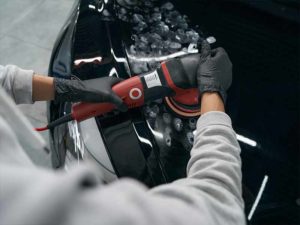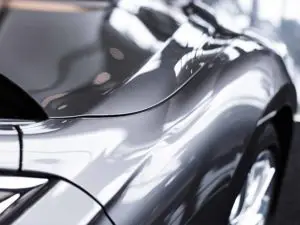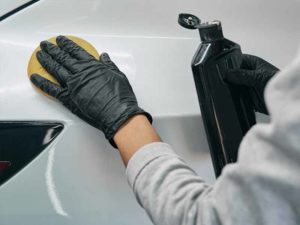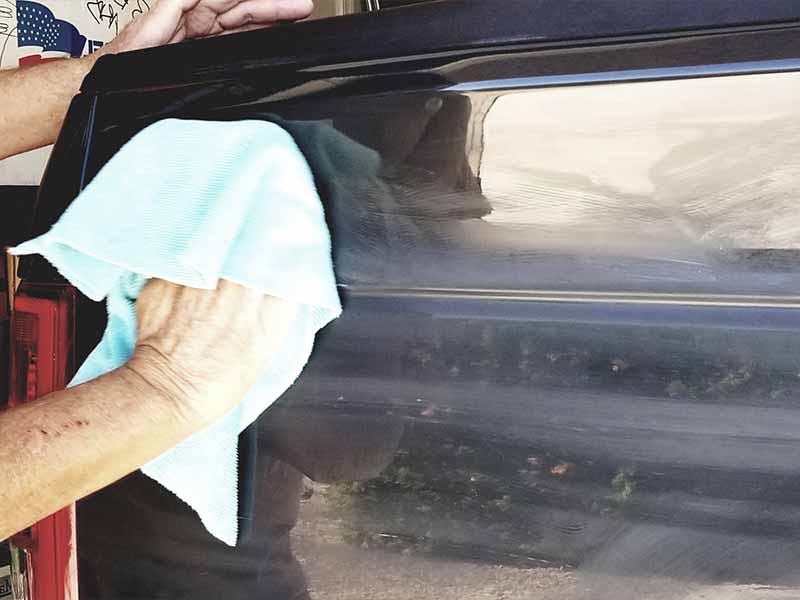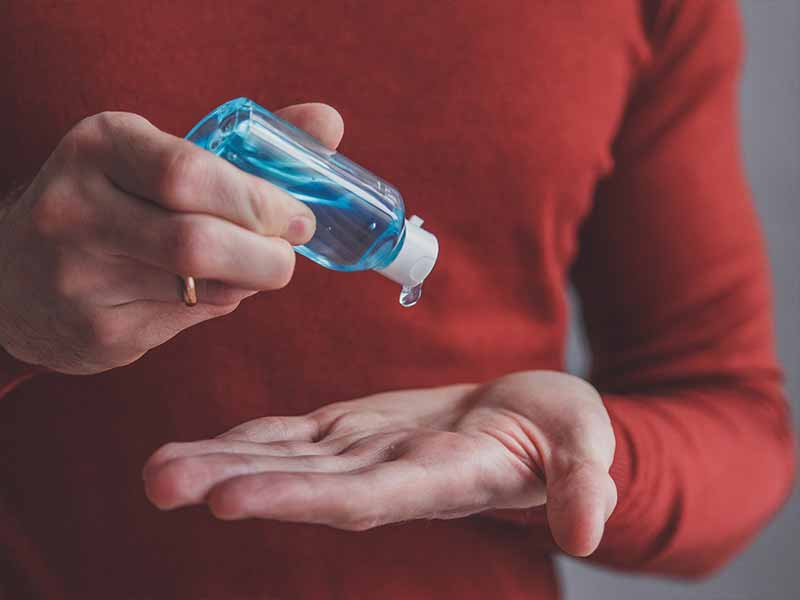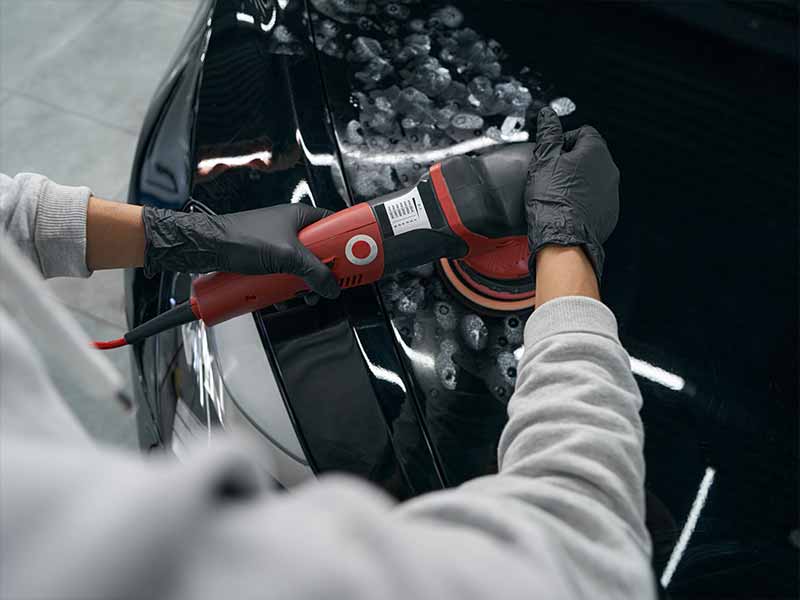Table of Contents
People often confuse an orbital buffer with a dual action polisher. Both get marketed as polishers but really only one is safe and capable of doing the job properly.
Dual Action Polisher Vs Orbital Buffer
An orbital buffer is an under-powered and difficult-to-use tool for delicate paint correction. Its only real useful purpose is to speed of the application of waxes and paint sealants.
Dual action polishers are extremely gentle but powerful tools that are great for either pros or beginners looking to correct car paint imperfections such as fine swirls, light scratches, paint stains, and oxidation.
Orbital polishers lack power, speed, and versatility to correct paintwork. Dual Action Polishers are extremely gentle yet powerful tools that even beginners can use safely to remove fine swirls and scratches from your clear coat.
Let’s dive in to the details of each tool and how to use them.
Buffer vs Polisher
Buffing is a car detailing process that generally uses an abrasive cutting compound that helps in the removal of vehicle imperfections like scratches, oxidation, and pigmentation. Using buffing machines will help to remove unattractive stains while also retaining the shine of the car’s surface.
Buffing is essentially the process of applying and removing wax. Buffing is meant to improve the gloss and shine without removing any paint or clear coat.
Polishing is a car detailing process that uses an abrasive polishing compound to remove minor defects like swirl marks, scratches, and stains. This process will remove a layer of the clear coat. Using a polisher will help to maintain your vehicle’s appearance for some time, but eventually you will wear through the clear coat if too much polishing is done or too many polishing sessions are performed.

What Is an Orbital Buffer?
Also referred to as a wax spreader (because it’s not good for much else), an orbital buffer typically spins a foam pad with a polishing bonnet placed over it.
Orbital buffers may be found that simply spin, are dual action (spin and orbit), or are even random orbital. Despite all of these variations, they are rather underpowered devices.
What Is an Orbital Buffer Used For?
These inexpensive tools can be easily found at big box stores and seem to be quite popular. Unfortunately, an orbital buffer can only really be used to apply and spread out wax.
Orbital buffers are great for helping speed up the application of wax. This is especially helpful with large vehicles such as trucks and SUVs.
Will an Orbital Buffer Remove Scratches?
Unfortunately, you are not able to remove swirl marks, water spots, scratches, or other significant imperfections in your car’s paint.
Orbital buffers simply lack the power to effectively remove fine scratches, swirls, or embedded paint stains.
How to Use an Orbital Buffer
As mentioned previously, the best use of an orbital buffer is for spreading wax on your car or truck more quickly. They can be very handy for this task, especially on larger cars, trucks, and SUVs.
As great as they may be for applying waxes and paint sealants to your finish, I wouldn’t recommend buying one for this task. A dual action polisher can also perform this task as well as perform delicate paint correction.
Step #1: Wash and Dry Your Vehicle
Before you can begin using an orbital buffer, you must give your vehicle a good soap and water wash, rinse, and dry. This process will remove any contamination that is currently on the paint and could potentially be absorbed by your buffing pad, which could end up causing more damage to your paint than what is already present.
After washing your vehicle, you could use a clay bar to remove further contaminants that may not have come off during the wash. This is an optional consideration. You can check your paint by using the baggie test to see if you’re finish needs to be decontaminated with a clay bar.
It’s important to not wax over heavy contamination as it will create spots the wax won’t adhere to and allow the elements to get under the wax and cause it to fail much more quickly.
Step #2: Prep Your Buffer
Choose the softest pad or bonnet you have available for your buffer. Apply your wax or paint sealant product heavily enough to the pad surface to coat the finish but not so much that it leaves excessive buildup in spots.
You may need to experiment a little with how much to apply to the pad to ensure that you’re not leaving pools of excess polish but not so little that you are having to stop frequently to reapply product to the pad.
You can use liquid waxes and sealants or pastes. Either can be used with a buffer to speed up application.
When using liquids, you can apply a few drops around the pad and dab the pad on the surface in a few spots to spread product around your working area evenly and work some into the pad. You may also want to initially work a light coating of liquid into the pad with your finger initially to better saturate the pad so it doesn’t absorb the product as you’re working rather than spreading across the paintwork.
When using pastes, apply the paste evenly across the the pad surface. You don’t want to overload the paste so that it builds up excess product on the paintwork. You don’t need to dab it on the finish like you would with a liquid though.
Step #3: Apply the Wax
Begin applying the wax to a manageable section of the vehicles surface. You may want to start with a smaller section and work up to what is comfortable. Half of the hood or a door panel may be a good size to try to cover.
Run the buffer in lines across the surface. Start from the most difficult to reach side of the section you’re working on to the nearest. Ensure coverage is uniform and not piling up. If piling up or pooling of product occurs, remove the excess with a microfiber towel and use less product next time.
Repeat the process on the next section. You’ll likely need to stop and buff off the wax or sealant that has been applied after a couple of panels have been applied. Cure times for waxes and sealants can be short and waiting too long to buff off wax can be very difficult. Follow the wax or sealant manufacturer’s recommendation for the cure time. Some may require extended cure times which will allow you to wax the entire surface before needed to come back and buff away.
A good tip for corded buffers is to through the cord over your shoulder to prevent it from swinging around and hitting your vehicle.
Step #4: Remove the Wax
After the product has been applied and allowed to cure for the manufacturer’s recommended amount of time, go back and buff off with a microfiber towel. Turn the towel frequently and avoid buildup on the towel surface.
Having several microfiber towels handy is always helpful when detailing. Also, microfiber is the safest fabric to use to prevent scratches. Microfiber is extremely soft and gentle on your finish. The nap of the microfibers traps abrasives that may be picked up and provides extra protection from swirls and scratches.

What Is a Dual Action Polisher?
A dual action polisher, also referred to as a DA polisher, makes use of dual action movement as it polishes or waxes a car’s surface. As the pad orbits and rotates at the same time, it produces an irregular shaking motion.
As a result, the machine polisher won’t burn the paint since the motion helps to reduce the buildup of heat and friction. These polishers are extremely beginner-friendly and can remove most swirl marks, surface scratches, and other stains and minor imperfections.
What Does Dual Action Mean?
Dual action means that the polisher spins on one spindle and the spindle itself rotates while allowing smaller circular motions to be made. Basically, the pad will rotate on a circle, and then there will be smaller circles made within the circle of the pad. This increases the efficiency and safety of the device, which is why a dual polisher is so great for beginners.
The motion is very similar to that of when you use your hand to polish paint on your vehicle. You tend to make smaller circular motions while also moving forwards or backwards or left to right. Rather than moving up or down or left to right, a dual action polisher moves in a circular motion.
Action 1 – Spin
Spin is the first action of a dual action polisher. Pretty simple and what you probably expect. The polishing pad simply spins around the center point.
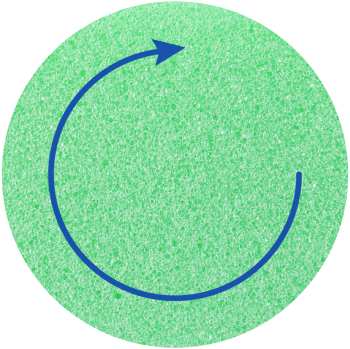
Action 2 – Orbit
The second action is the orbit. The orbit is the pad orbiting around the center point of the polishing pad.
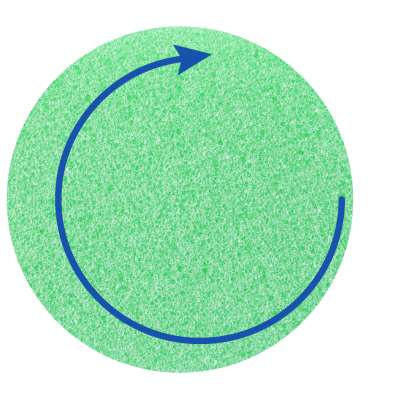
Dual Action
The combination of these 2 actions reduces heat buildup and is much safer for your finish. It mimics a motion similar to what people naturally do when polishing by hand.
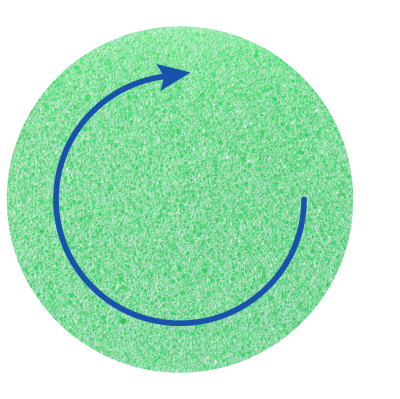
What Is a Dual Action Polisher Used For?
Dual action machine polishers can be used for many things, including removing swirl marks and minor paint scratches, removing embedded stains, and generally improving the appearance or luster of a car’s surface. It can also be used for polishing chrome and soft metals. It is great for speeding up the waxing process as well.
However, it is imperative to understand that a DA polisher cannot remove any scratch or flaw that has penetrated through the clear coat layer. If your fingernail is able to dip into the scratch, a dual action polisher is not going to be able to remove these types of issues.
The reason a DA polisher can’t remove deep scratches is that scratches that are all the way through the clear coat need to be repaired and can’t be polished away. You’d have to polish through the entire clear coat which will leave a dull spot and exposed paint, unprotected by the glossy clear coat.
Types of Dual Action Polishers
There are 2 main types of dual action polishers:
- Random Orbital
- Forced Rotation
Dual action polishers have 2 actions:
- spinning of the pad
- orbit of the pad
The difference between the 2 main types of dual action polishers is the way the second action is propelled.
- Random orbital polishers propel the orbiting action by momentum.
- Forced rotation polishers propel the orbiting action directly via the electric motor.
Random Orbital Polishers
Random orbital polishers have both of these actions, but they are not necessarily in sync which randomizes the polishing pattern.
Random orbital polishers are a preferred type of polisher since the randomized polishing pattern will be far less likely to create holograms in your paint.
Also, random orbital polishers will stop spinning when too much pressure is applied to the polisher. This is great for beginners and makes it much more difficult to use the polisher in a way that would burn through the clear coat.
Forced Rotation Polishers
A random orbital polisher is not forced to spin, but rather it rotates as a result of the momentum created by the high-speed motion. It is a very simple and easy to use polisher for beginners. As stated in its name, the pattern of motion is random based on the speed, pad size and grip, and stroke length. However, it is not as strong as a forced rotation dual action polisher.
A forced rotation dual action polisher offers two different spinning motions that are synchronized. While forced rotation polishers are still great dual action polishers and reasonably safer on automotive finishes than fixed orbital polishers, they a more aggressive than random orbital polishers due to the forced rotation that will not stop spinning when excessive pressure is applied to the polisher.
Is a Dual Action Polisher Better?
If you are a beginner to detailing your vehicle, a dual action polisher is often the first recommended equipment to use. It is a device that can be used to transition from hand polishing or waxing to machine polishing/waxing.
Further, DA polishers will create a less stressful and time-consuming experience. You won’t spend nearly as much elbow grease or time using a dual action polisher as you would doing the process by hand.
Plus, dual action machine polishers rotate in two different circular flow patterns, reducing the friction and heat buildup that can be created and cause damage to your auto paint.
In addition, dual action polishers will stop spinning when too much pressure is applied. This prevents beginners from burning the paint by leaning too heavily on the machine accidentally.
Can You Buff with a Dual Action Polisher?
Yes, DA polishers can be used to buff wax onto your car or truck’s finish. Quality DA polishers will have slower settings to use specifically for applying wax or sealant.
How to Use a Dual Action Polisher
Step #1: Wash Your Vehicle
Before you can begin using a polisher of any kind, you must thoroughly wash and dry your vehicle. This process will remove any pieces of sand, dirt, and grit that could potentially be absorbed by your polishing pad and create more swirls and deeper scratches rather than removing them.
Step #2: Inspect the Paint
As soon as the car’s paint surface is clean and dry, you need to inspect the surface so you know exactly what you are dealing with. This inspection will also help you identify the type of pad you need to use with your dual action polisher.
Making sure it’s dry, run your hand across the car’s surface. If the paint feels rough, then you need to use a cutting pad and polish the finish. However, if the paint is smooth and riddled with minor scratches, swirl marks, and water spots, you will want to use a polishing pad.
Step #3: Remove the Paint Imperfections
Apply the appropriate cutting pad to your dual action polisher and apply compound to the surface of the pad. The pad should be saturated with the product before applying it to the car’s surface. In order to work the product onto the paint, use back and forth motions.
Make sure you are only working on one section at a time. 2 foot x 2 foot sections are a good size to focus on. When you are finished with one section, move on to another.
Step #4: Polish the Paint
Once you have compounding all of the paint defects, it is time to polish the paint for a glossy shine. Simply switch out your cutting pad for a polishing pad and apply a moderate amount of polish onto the pad.
Again, make sure the pad is relatively saturated before using it on your vehicle. You will also want to use a back and forth motion, which permits full coverage. You also want to work on one section at a time, and when you move to a new section, apply more polish to the pad.
Step #5: Wax the Surface
Last, but not least, you will want to use the dual action polisher to apply wax to the vehicle’s paint surface. The wax will offer an additional layer of protection against UV rays, dirt, and more.
You will follow the same steps as you did when removing flaws and polishing the paint except you will add a finishing foam pads to the device. When applying the wax, make sure it is being applied in an even, light coat. You aren’t trying to cut and remove flaws any longer.
The wax should be left to dry to a light haze and then removed with a dry, clean microfiber cloth.

The above promotional photo provided by Porter-Cable is an excellent demonstration of how not to use a dual action polisher. Always keep the power cord over your shoulder to keep it from brushing against the paint surface.
Best Dual Action Polishers for the Money
There are many different polishers available on the market that offer the popular and less damaging dual action rotating motion. The dual action movement prevents further damage to the paint.
Here is a look at some of the most popular DA orbital polishers on the market that won’t break the bank.

Meguiar’s DA Power System
The DA Power System is a great choice if you’re trying to save every penny but want a safe and effective polishing solution. It’s a true dual action polisher but uses your power drill to drive the polisher.
This system gets rave reviews by many users. It should be noted though that a random DA orbital polisher will be easier to use and able to work much faster and consistently. But this tool can do a very competent job.
This solution works well but comes with several compromises. Let’s go over the pros and cons:
Pad Size:
- 4 inch
Pros:
- Price
- Able to do everything a traditional DA polisher can
Cons:
- Speed settings aren’t available
- Requires a drill capable of at least 1200 rpm
- It is a little more awkward to use than a true DA polisher
- Small pad size means more work
- Not compatible with most types of pads
- While the buffer head spinning motion slows down under too much pressure, it doesn’t completely stop and prevent paint burn like a quality dual action random orbital polisher.
Bottomline:
If you’re going have a need for a DA polisher but don’t want to spend much money and won’t be using it frequently, this is a very smart choice.
The DA Power System is more than capable of doing all the work a typical DA orbital polisher can at a fraction of the cost. If you’re going to be doing big jobs and using it more frequently, you may want to consider stepping up to a traditional-style polisher.

Porter-Cable 7424XP
If you have a little more wiggle room in your budget, the Porter-Cable DA orbital polisher is perfect for you. It is still great for beginners and has the capability of fitting most pads, ensuring your vehicle receives a solid buffing and polishing. It even comes equipped with a removable side handle that makes it easier to hold and control when in use.
With a higher orbiting rate than some of the other polishing machines on the market, it can produce effective results without harming your paint.
Pad Size:
- 6 inch
Pros:
- Inexpensive traditional dual action polisher
- Compatible with most typical polishing pads
- Compact design is easier to use
- Excellent build quality on a budget
Cons:
- Spending a little more money can get you a lot better polisher
Bottomline:
Porter-Cable is a quality tool manufacturer and this entry-level dual action orbital polisher is no exception.

Griot’s Garage G9
Of the budget dual action polishers on the market, the G9 by Griot’s Garage is the best bang for the buck if you’re looking for a good quality, full-featured random orbital rotary polisher that is professional-grade.
Pad Size:
- 6 inch
Pros:
- Professional Detailer Grade
- Light Weight
- Detachable Cord
- Excellent Build Quality
- Low Vibration
- Extremely Powerful
- Speed Dial & Switch Lock
Cons:
- Beginning to get expensive for a beginner polisher
Bottomline:
For a very reasonable price you can get a professional-grade dual action random orbital polisher that can handle big jobs but also is easy to use and beginner friendly.
If you don’t mind spending a little more, it is a tool that will last you for quite a while and is capable of delivering professional results over and over again.
Helpful Links
Conclusion: Dual Action Polishers Vs Rotary Buffers
The dual action polisher will win every time due to what they can offer, especially when you consider the fact it can buff and polish based on the pad and compound you use.
Most professional detailers will use a dual action polisher over a traditional orbital buffer because it is a safe and beginner-friendly tool than the clumsy and underpowered buffer. It can essentially do the same thing as a traditional orbital buffer but do a better job at it.
Hopefully, this information has helped you understand that the old fashioned single-action rotary polishers of the olden days are best avoided despite their incredibly cheap price. Stick with a proper dual action tool for the best results.
Good luck!


